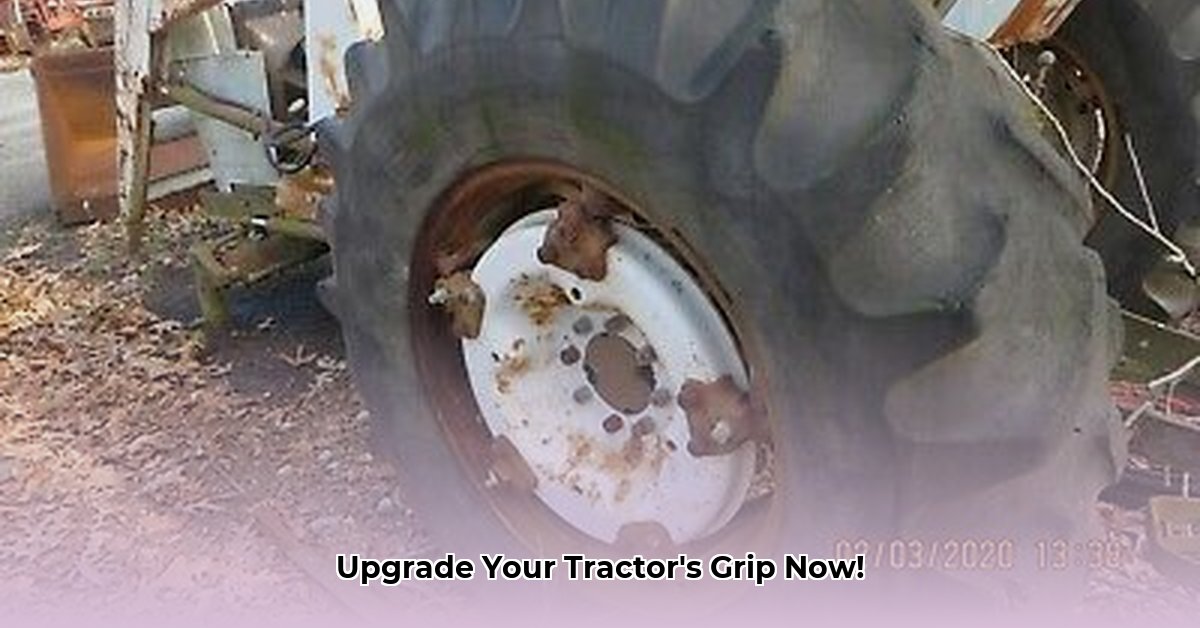
This comprehensive guide helps farmers select the ideal 18.4 x 30 tractor tires, maximizing performance, longevity, and minimizing downtime. We’ll decode tire specifications, guide you through the selection process, and provide essential maintenance tips. While comprehensive comparative data remains limited, this guide offers actionable steps for informed decision-making. For larger tires, check out our guide on 18.4-38 tractor tires.
Decoding the 18.4-30 Tractor Tire Specification
The seemingly simple "18.4-30" designation provides crucial information about tire size and fit. The "18.4" represents the tire's width in inches, while "30" indicates the wheel's diameter in inches. Matching these dimensions to your tractor is critical for safe and optimal performance. Incorrect sizing leads to handling issues, reduced efficiency, and potential damage.
Key Features of 18.4 x 30 Tractor Tires
Several key features significantly impact tire performance and lifespan. Understanding these characteristics is crucial for making an informed choice.
Ply Rating: Strength and Durability
Ply rating signifies the number of fabric layers within the tire, directly correlating to its strength and load-carrying capacity. A higher ply rating (e.g., 12-ply) indicates greater durability, making it ideal for heavy-duty applications. Isn't a tough, reliable tire essential for minimizing downtime?
Tread Pattern: Traction Tailored to Terrain
Tread patterns profoundly influence traction. Deep lugs provide superior grip in muddy conditions, whereas shallower treads perform better on hard-packed soil. Matching the tread to the terrain optimizes traction and fuel efficiency. Which tread pattern best suits your typical farming conditions?
Construction Materials: Building for Resilience
The materials used in tire construction impact their resistance to punctures, tears, and overall longevity. High-quality materials contribute to a longer lifespan and minimize costly repairs. Isn't durability a key factor in maximizing your return on investment?
Choosing the Right 18.4 x 30 Tractor Tires: A Step-by-Step Guide
Selecting the perfect tire involves a systematic approach. Follow these steps to ensure a good fit for your needs and working conditions.
Step 1: Assess Your Farming Operation: Analyze your soil types (clay, sandy loam, rocky), tractor weight (including typical loads), and intensity of use. This assessment guides your tire selection.
Step 2: Determine the Necessary Ply Rating: Based on your assessment, choose the appropriate ply rating. 12-ply tires are recommended for heavy-duty applications, while lower ply ratings might suffice for lighter workloads. Remember, safety and durability should be prioritized.
Step 3: Select the Appropriate Tread Pattern: Match the tread pattern to your soil conditions: deep lugs for mud, shallower treads for hard-packed soil. Proper traction ensures efficient and safe operation.
Step 4: Verify Load Capacity: Ensure the tire's load capacity rating meets or exceeds the combined weight of your tractor and typical load. Overloading dramatically shortens tire life and increases risk of failure.
Step 5: Consider Reputable Brands: Research established tire brands known for quality and durability. While detailed performance comparisons are limited, choosing reputable brands minimizes the risk of purchasing inferior tires. Do you prioritize proven reliability or a lower initial cost?
Step 6: Balance Price and Value: Assess the long-term cost. A seemingly inexpensive tire may prove costly due to shorter lifespan and increased maintenance.
Tire Maintenance: Extending the Life of Your Investment
Proper tire maintenance is crucial for maximizing tire life, performance, and fuel efficiency.
1. Proper Inflation: Maintain the correct tire pressure as specified by the manufacturer. Underinflation reduces fuel efficiency and increases wear. Overinflation can damage the tire structure. Regular pressure checks with a reliable gauge are essential.
2. Regular Inspections: Inspect tires regularly for wear, cuts, embedded objects, and bulges. Early detection prevents major problems and reduces downtime.
3. Tire Rotation: Rotate tires regularly to promote even wear and extend their lifespan.
4. Proper Storage: Store unused tires in a cool, dry place, away from sunlight and extreme temperatures.
Addressing Data Limitations
While this guide provides essential information, comprehensive comparative performance data for 18.4 x 30 tractor tires is often unavailable. Independent testing is needed to provide more concrete performance comparisons.
Risk Assessment: Potential Failures and Mitigation Strategies
| Factor | Likelihood of Failure | Impact of Failure | Mitigation Strategy |
|---|---|---|---|
| Tire Punctures | Moderate | High (downtime, repair) | Puncture-resistant tires; proper inflation; avoid sharp objects |
| Excessive Tread Wear | High | Medium (reduced traction) | Regular inspection and rotation; correct inflation; avoid overloading |
| Manufacturing Defects | Low | High (safety risk, repair) | Purchase from reputable brands with warranties |
| Inadequate Load Capacity | Moderate | Very High (tire failure) | Accurate load capacity calculation; avoid overloading |
Remember, the right 18.4 x 30 tractor tires are a significant investment impacting your farm’s efficiency and profitability. Prioritize durability, traction, and consistent maintenance for optimal results.